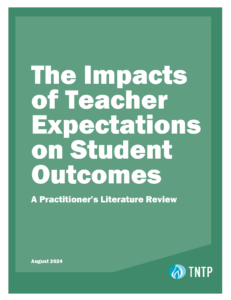We all know that highly effective teachers can have a lifelong impact on students. But we also know that too often, the students who need great teachers the most are the least likely to get them. Now state leaders are being tasked with tackling that problem. By June, all states must submit plans to the USDoE, detailing how low-income students and students of color will be assured equitable access to great teachers.
States can play a leading role in giving schools and districts the flexibility they need, making sure they report data transparently, and sharing knowledge. As the deadline approaches, here’s what we recommend state leaders keep in mind as they craft their equity plans:
Establish goals for principal performance. Quality school leaders are crucial for high-need schools to attract and retain high-performing teachers. As part of their equity plans, state leaders should go beyond solely focusing on teacher equity metrics and also include targets for improving principal hiring, effectiveness and retention. They should also look to principal ratings and retention rates to identify which districts and schools require additional support.
In Charlotte, the Strategic Staffing Initiative offers an example of a district-led initiative to attract high-performing principals. Giving high-performing principals additional compensation, increased autonomy over school decisions and staffing authority has helped schools attract strong new teachers and improve student outcomes.
Provide staffing flexibility to high-need districts and schools. Emerging turnaround models across the country demonstrate the potential of providing leaders of high-need schools with the flexibility to hire the right teachers for their schools.
In the Memphis Innovation Zone, schools with student achievement rates in the bottom five percent across the state are provided additional funding for signing and retaining their most effective teachers. Principals are also given full authority to staff their schools as they see fit, early access to hire teachers before other Memphis schools and policy protections to ensure they only hire staff rated “effective” in previous schools. After a single school year of this approach, Memphis iZone schools averaged double-digit gains in reading, scientific reasoning and math.
Allow districts with significant equity gaps to pilot new approaches to structuring schools. School design has changed little over the last century, but expectations for educators—and students—have increased dramatically. Wherever possible, state leaders should give district and school leaders greater flexibility in how they configure their staff and structure their school days. Age-old policies often restrict high-need schools from implementing alternative models that might better serve their students’ unique needs.
With increased flexibility, high-need schools can focus on expanding the reach of high-performing teachers by providing them with time to lead planning and development with peers in their grade level or subject area, and by maximizing the time they spend on instruction. They can also tap into emerging best practices like blended learning, to provide high-need students with access to the best content and instruction available.
In New Hampshire, a significant policy shift allowed high schools to abandon mandated credit hours and embrace a competency-based model. As a result, schools were given the flexibility to create personalized learning paths for students and leverage their individual strengths. This approach is particularly helpful in creating supportive environments for high-need students and setting them up for academic success.
Promote data transparency and establish rewards and consequences for districts to eliminate their equity gaps. States should facilitate regular access to clear reports on the distribution of effective teachers within their districts in order to increase awareness of disparities. Equipping district and school leaders with data and empowering them to take action tailored to their unique context should help close equity gaps over time.
Districts that make significant progress to improve their equity gaps should be publicly celebrated and rewarded with funding to expand successful initiatives. Likewise, districts that don’t make enough progress should receive increased oversight and assistance to help them provide stronger educators to high-need students.
Share knowledge about district-level innovations. States should serve as a clearinghouse for tools, resources and ideas. Georgia’s department of education has a robust online portal to facilitate virtual dialogue between districts. Creating spaces that encourage districts to share knowledge, successes and failures benefits the entire state.
Giving our most vulnerable students access to great teachers has proved difficult for decades. But that only means we should double down on our efforts to address this issue. State leaders should be bold and innovative when submitting their equity plans come June, but they also shouldn’t pressure themselves to submit the perfect plan. These strategies will evolve in the years ahead, as leaders see what works and what doesn’t. Devising an equity plan now is only step one in a complex—and multi-year—process. Nonetheless, we all have a moral imperative to make every effort we can to give low-income students and students of color what they deserve—nothing but the best instruction.








